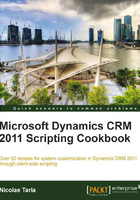
What this book covers
Each of the chapters in this book adds incremental information, and is based on the prior knowledge gained from previous chapters. For a user that has already knowledge of customizing Dynamics CRM through scripting, you can skip to the recipes of interest, or follow along and see if there is anything new.
Chapter 1, Overview of Dynamics CRM 2011 Customization, introduces the concept of solution packages, and presents the scripting model used for Dynamics CRM 2011. In addition, basic system configuration and settings that work in conjunction with your customizations are presented.
Chapter 2, Scripting Form Fields, covers the most common scripting customizations used when working with various basic form elements. We look at the various field types and how to work with these values.
Chapter 3, Field Validation, includes various validation approaches to enhance the out-of the-box validation rules. In addition, this chapter presents various approaches to presenting and collecting user input to minimize errors.
Chapter 4, Rules and Events, introduces the reader to the various events presented by Dynamics CRM 2011, as well as working with other form elements available for customization.
Chapter 5, Error Handling, introduces the concept of handling user errors, processing errors, and explains how to prevent the default system behaviors. The advanced topic shows ways to override the default system behavior with custom processing and capturing of user input.
Chapter 6, Debugging, delves into details of working with the scripts and using the available tools to handle various situations where your script misbehaves.
Chapter 7, Extended UI Manipulation, demonstrates ways to introduce visual elements to your forms to highlight form elements and also demonstrates how to handle presenting only the relevant information to a system user.
Chapter 8, Working with Ribbon Elements, is focused on working exclusively with the Ribbon. From adding and removing Ribbon elements, working with events attached to Ribbon elements, and presenting additional information on the Ribbon, most aspect of client-side Ribbon customizations are presented in an easy-to-follow way.
Chapter 9, Extending CRM Using Community JavaScript Libraries, tackles the use of external prebuilt libraries in conjunction with Dynamics CRM 2011. Some of the most popular JavaScript libraries are presented in the context on Dynamics CRM. They will either help you in writing shorter, more efficient scripts, or handle specific form actions.
Chapter 10, Light Social Media Integration, presents a few approaches to bringing information from various social media resources into your Dynamics CRM 2011 environment, with no additional load to server resources. The ways presented here are exclusively client side, and require the system user to have access to these social networks directly.